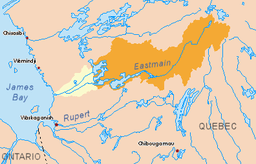Eastmain River
| Eastmain | |
| River | |
 Eastmain River in Dec. 2005 at the James Bay Road. | |
| Country | Canada |
|---|---|
| Province | Quebec |
| Region | Jamésie |
| Source | Lac Bréhat |
| - coordinates | 52°31′30″N 70°52′00″W / 52.52500°N 70.86667°W |
| Mouth | James Bay |
| - location | Eastmain |
| - elevation | 0 m (0 ft) |
| - coordinates | 52°14′30″N 78°34′00″W / 52.24167°N 78.56667°WCoordinates: 52°14′30″N 78°34′00″W / 52.24167°N 78.56667°W |
| Length | 756 km (470 mi) [1] |
| Basin | 46,400 km2 (17,900 sq mi) [1] |
| Discharge | |
| - average | 930 m3/s (32,840 cu ft/s) [1] |
 Eastmain River original basin in yellow and orange. Diverted basin in orange. | |
The Eastmain River is a river in northwestern Quebec which rises in north central Quebec and flows 800 km west to drain into James Bay. 'East Main' is an old name for the east side of James Bay. This river drains an area of 46,400 km². The First Nations Cree village of Eastmain is located at the mouth of the river.
Since the late 1980s, most of the waters of the Eastmain River have been diverted and flow northwards through the Opinaca Reservoir, with a surface area of about 950 km², and into the Robert-Bourassa Reservoir of Hydro-Québec's La Grande Complex. The remainder of the Eastmain River only contains a fraction of its former volume, permitting freeze-up in winter (see photo).
A further hydroelectric project on the upper Eastmain River is currently under construction (2005). The project was part of the original hydroelectric project provided for by the James Bay and Northern Quebec Agreement of 1975. The Eastmain Reservoir will eventually have a surface area of about 600 km² and the Eastmain-1 power plant will generate a maximum of 900 MW.
The Eastmain river was named after the Hudson's Bay Company's East Main District which was located east and south of Hudson Bay. The mouth of the Eastmain was a center of the fur trade. Charles Bayly reached it from Rupert House in the 1670s. After Rupert House was destroyed in 1686 the area was visited by a ship from York Factory. In 1723-24 Joseph Myatt of the Hudson's Bay Company built a post.[2]
See also
References
- 1 2 3 Atlas of Canada (all values of original river prior to hydro-electric development.)
- ↑ Arthur S Morton,"A History of the Canadian West to 1870-71", no date, circa 1950